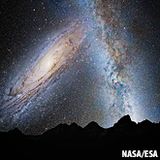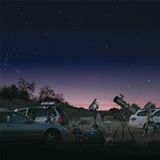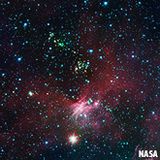
If you're like millions of other people, I'm sure you've looked up at night and wondered about your place in the Universe - and maybe you'd like to experience just where you are. Fulfilling this wish doesn't take money. All it takes is a clear dark night, a safe place to view and an open mind.
What you're going to do is spend a summer night outdoors watching the Earth turn slowly and contemplate your position both in our solar system and within our galaxy. Before you say that you've been out all night before, stop to consider that you might have spent at least some of that time viewing through a telescope, or perhaps pursuing a meteor shower. On this night, all we're going to do is watch the sky.
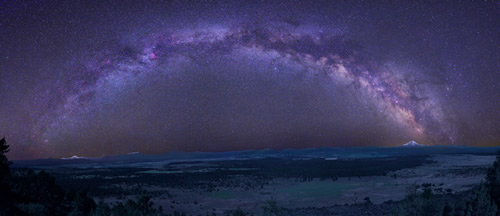
"A Graceful Arc" courtesy of Tony Hallas
This experiment requires that you see to your comfort, so be sure to use a well-padded reclining lawn chair and see to your needs before you begin. Take along coffee (or another favorite beverage), things to snack on, perhaps insect repellent or a blanket. Be sure to grab sunglasses to put on before you need to make those "necessary" trips indoors to protect your night vision. Why not enjoy a radio while you're at it? Music hath charms...
As you relax and the sky becomes dark, look for the familiar constellations as they come out to play. If you conduct this experiment during the late summer months, the most important sky feature you'll be looking for is commonly called the Milky Way. If you are viewing from a dark sky location, you can't miss this huge swath of stars cutting its way overhead. This isn't truly the Milky Way - yes, it's our galaxy - but it is a single branch of the magnificent spiral in which we live.
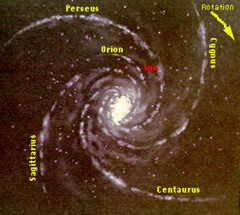
Milky Way Arms Visualization (NASA)
If you look to the south, you'll see the constellation of Sagittarius. Can you see the spout of the teapot and how the stars seem to thicken in that area? There's a good reason for that - it's the direction of the center of our galaxy. When you look at the great arch of stars called the Milky Way, you see it as it appears from the constellations of Sagittarius, through Cygnus and into Cassiopeia. It looks like a single band, but it isn't. When you look towards Sagittarius, you're looking in the direction of the center of our galaxy, but you're actually seeing the huge spiral arm of the one next to ours.
As you move northward and into Cygnus, you're looking at our local spiral arm - the Orion - just a minor branch of the Sagittarius. When you've reached Cassiopeia, you're looking outward and into the spiral arm just outside the Orion. Any further and you're outside our galaxy! As time passes, you'll see more and more details like dark dust lanes known as the Great Rift, nebulous regions and concentrated star clusters. Note the direction it takes across the sky, because the movement is going to blow your mind as the night passes!
As you're watching, let's begin making mental notes. Have you identified any planets yet? Good for you! Perhaps there might even be a crescent Moon present on the night you're observing. These objects move on a path across the sky known as the ecliptic plane. For most observers, this imaginary line in the sky runs loosely from the east/southeast to the west/southwest. Maybe you'll be lucky enough as you're watching to see a body rise or set. It's quite an experience to notice how quickly this happens when it's near the horizon!
Ah, the Milky Way.... You're beginning to notice something, aren't you? Over the hours the constellations overhead have moved directly from east to west. Things positioned to the south have come and gone in a shallow arc, while the objects to the north have turned tightly around Polaris. When you take a stretch break, point to Polaris with one arm and with the other, point at that same angle to the ground. Wow! You've just captured Earth's axial tilt! Now, the way those stars seem to move across the sky makes more sense... But not the MilkyWay, eh?
As the hours pass, the most brilliant of the Milky Way's spiral arms doesn't just move from east to west like everything else. If you've observed, you'll see that it seems anchored somehow, and it is twisting overhead. That's because it resides along another path in the sky - the galactic plane. Just as the planets orbit the Sun on their own flat track, the ecliptic, we're looking both inward and outward from our position in the Milky Way to see where the galaxy's spiral arms are located around its center.
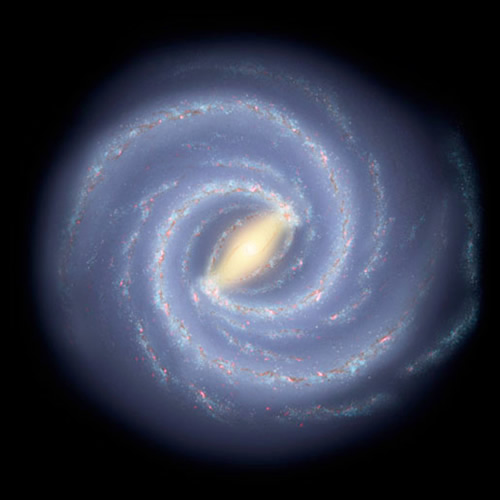
Milky Way Galaxy Artist Concept (NASA)
If you have been observant, you'll notice another concentration of stars is beginning to make an appearance as well - this time to the northeast. If you've guessed that it is another spiral arm, then you'd be correct. The Perseus spur is slowly beginning to curl around to join the Cygnus and Sagittarius. If your observations occur in the autumn, then you'll also be able to witness the rise, just before daybreak, of the edges of the Orion spur to the southeast as well. The Orion Arm is where our solar system calls home and its bright stars will soon march across the sky, hidden by the overpowering glow of day.
Are you dizzy yet? When you stop to think, you'll find you're on a spectacular cosmic merry-go-round. We are grounded by gravity here on a tilted Earth. As it spins, we see this movement as changes in the celestial sphere. Crossing it is the ecliptic plane where the Sun, Moon and planets journey from our point of view. At the same time, the Earth is orbiting the Sun and our entire solar system is lodged in a spiral arm of stars which is orbiting the galactic center. But, there's more. Don't forget our Universe is expanding and our galaxy itself is on the move, too!
Of all the things you can do in life, you owe it to yourself to spend just one night outdoors... wrapped in the loving arms of the Milky Way!
What's the most awe-inspiring fact you learned in this article? Share with us in the comments!
Tammy is a professional astronomy author, President Emeritus of Warren Rupp Observatory and retired Astronomical League Executive Secretary. She?s received a vast number of astronomy achievement and observing awards, including the Great Lakes Astronomy Achievement Award, RG Wright Service Award and the first woman astronomer to achieve Comet Hunter's Gold Status.




